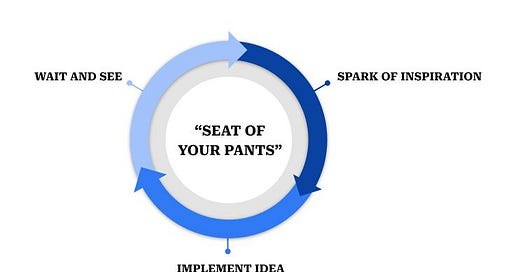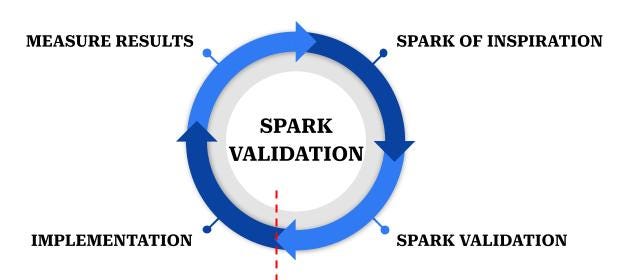The Spark Is Not the Strategy
A gut feeling can light the way—but only if you test it before you jump in.
One of the most-romanticized characteristics of entrepreneurs and builders is this :
Damn the torpedoes.
Or rather… carry on at full speed and commit to your ideas. Inspiration strikes, so seize the moment. Be bold, be resolute, and be unyielding in your focus.
Sometimes this mantra works out, sometimes it doesn’t. With this simple, chase-your-gut-feeling approach, the cycle of ideation looks something like this—
In my experience, the heap of ideas which seemed great but failed is much larger than the heap of ideas which seemed great but were also truly transformative for a business.
Should we ignore those sparks of inspiration, knowing most won’t pan out?
Resoundingly, no.
Ideas which come from the spark of inspiration also carry with them some powerfully intrinsic motivation. They’re exciting, they represent change, and they ride on that bolt of electricity that drives many entrepreneurs and builders—the notion of creating something.
So, we should trust in our sparks of inspiration—but also make every effort to beat up the ideas which come from them. To test our underlying assumptions without malice or mercy, for the ideas which make it through a bit of a punishing and still seem viable at the end are the ones which have a much better chance of being successful.
And, they’ll have a better chance of actually seeing the light of day too.
The Reality of Execution
How many times has one of the serious operators in your business looked at you with that I’m-pulling-my-hair-out-right-now side eye after you’ve described a new idea? How many times have they expressed to you how hard the idea will be to implement, or how disruptive it will be to a given team, or how it will distract from other things which are “more important”? There are always more reasons not to do something than to do it.
I’m almost certain that this has happened to you. Heck, I’ve been on both sides of it… the person getting the side eye and also the person giving the side eye.
This type of pushback almost never comes from a direct and automatic criticism of the idea itself—often, it comes from the notion that endlessly chasing new ideas wastes considerable time and simply makes it more difficult to manage the things already on the table (which it often does). If you have one of these people in your orbit, be grateful—they’re a rare breed, and will be extremely useful as you begin to calibrate your cycle of ideation (more on that later on in this post).
Thinking about ideation from the perspective of execution for a moment… let’s say that one in ten of the ideas generated through these sparks of inspiration are actually viable for your business. And, let’s say that each idea takes a month to fully deploy and perhaps another month to measure.
The Value of Validation
If your sparks of inspiration generate ten ideas… then you’ll spend ten months implementing them and ten months deciding if they’re truly valuable or not. No matter what way you slice it, you’re probably not realizing full value from this basket of sparks for a year.
But if we approach ideation a bit differently, then we can shorten the pathway to getting favourable outcomes (or at least, skew the probabilities a bit more in our favour).
Let’s say that we spend a week intensively subjecting each spark of inspiration to a validation process. Assuming that we’re still generating a valid idea from a spark of inspiration one time out of every ten and each valid idea still takes a month to implement and another month to measure, then :
We spend two and a half months on validation (one week each for ten ideas) ;
We spend one month on implementation ;
We spend one month measuring and confirming that our spark of inspiration which survived validation is actually delivering value to the business.
By adding a validation process to our cycle of ideation, we spent four and a half months on the same basket of new ideas to get the same outcome (instead of the twenty months’ invested with the seat-of-your-pants approach). As an entrepreneur or builder, what would you do with the other sixteen months’ of saved time? That unlocked time is likely to be extremely valuable to you and those around you.
This is a very simplified chain of reasoning, of course.
In practice, ideation and implementation can work in parallel. It also doesn’t necessarily take a month to implement an idea… it could be considerably less (and it could also be considerably more).
The chain of reasoning is still valid though—if you invest some time up front to validate your sparks of inspiration before acting on them, you’ll very likely drive innovation and value creation in your business with far less wasted time. The amateur economist trapped inside of me screams that this is also a powerful way to support and improve the overall productivity of your growing business.
How to Validate Your Sparks
Validating a spark of inspiration isn’t necessarily about proving beyond a shadow of a doubt that a given idea will be successful—none of us has a crystal ball, after all. Rather, spark validation is about stress-testing an idea robustly enough so as to build confidence that the given idea could work. As a bonus, effective spark validation also starts to clarify under what conditions the idea could work.
This full post ended up longer than expected—apparently, I had thoughts. To make soaking it in a bit more manageable, I’ve split the topic into four parts :
Inspiration is fuel—but without validation, it’s just smoke. Before you pour time and money into your next great idea, take a breath. Beat it up, ask yourself the hard questions and make sure that it’s worth building. Your future self—and your team—will thank you for it.
Feedback
Improving The Journey is a journey in itself. Want to send me some feedback on this post? Click here (it’s completely anonymous) : https://6catalysts.ca/subscribe/the-journey-feedback/.





